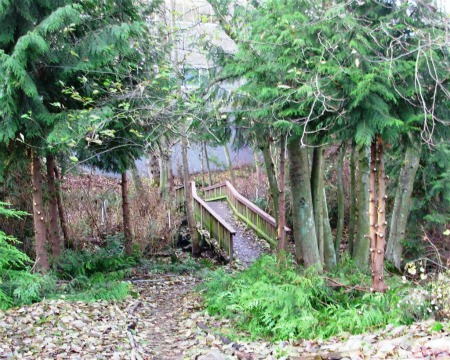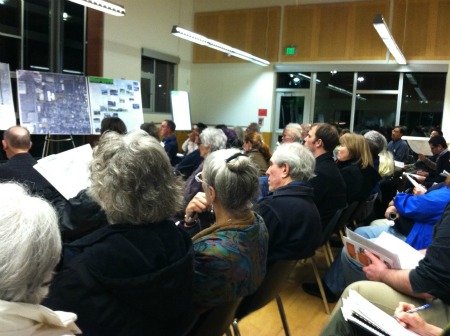More than 50 people gathered at Northgate Community Center on Wednesday night to discuss the future of Beaver Pond Natural Area, and how best to spend $500,000 on a restoration project to protect the green belt while still meeting the needs of the community.
Safety was on the minds of many of the attendees after nearly 50 trees were illegally pruned in the southwest side of the park last month, with opinions running strongly on both sides of the issue. A neighbor who lives adjacent to the park on Northeast 104th Street says although he realizes that the tree trimming was illegal, he and his neighbors like it that people can see better into the park.
 “Before it was completely sheltered from any sort of observation,” he said. “I think that really encouraged the activity that was going on there. I like nature, but there’s a balance.”
“Before it was completely sheltered from any sort of observation,” he said. “I think that really encouraged the activity that was going on there. I like nature, but there’s a balance.”
In contrast, multiple attendees seemed more supportive of the natural area remaining natural. A few urged those who believe criminal activity is taking place in the park to be proactive about putting a stop to it by forming watch groups that coordinate with the police and Parks.
Janet Way, who has been involved with the creek’s restoration since the Thornton Creek Alliance was formed in 1994, says she has dealt with many of the same issues in her section of the watershed in Shoreline.
All it took was a few months of regular patrols that reported their findings to police, and the illicit activity quickly disappeared, she said. “If you see a problem, call 911,” she added, a theme that was repeated throughout the night.
The safety theme also remained a constant, with Parks arborist Mark Mead explaining that this is the community’s opportunity to shape the natural area into a space that makes them comfortable. He noted, however, that it’s doubtful the trees are the cause of any crime that could be linked to the neighborhood.
“The reality is that the topography is what is causing the problem, not the trees,” Mead said. “I haven’t heard of a tree yet causing a crime.”
Indeed, Mark Garff, who presented part of the restoration plan as part of the consulting group The Watershed Co., said in a way the natural area acts as a buffer between the mainly single-family residences in Maple Leaf and the heavily used retail/multifamily dwellings on the opposite side of the green belt (we hope to have a link to a map that clearly marks the natural area and restoration plans later this week).
“This natural area has a lot of pressure on it from both sides,” Garff said. “There’s a neighborhood that would like more of a park, and this very urban area where there’s a lot of people.”
But in the middle of it all is the largest area of continuous canopy around, he said, “so this area really is worth protecting.”
He and colleague Marina French explained that although the restoration project will likely include improved trails, signs and access, those amenities will not only help increase the number of people who use the park, but they also can better protect the natural area by keeping people on proper paths rather than encouraging them to trample through protected areas.
In addition to decreasing impact to the natural area, improving access also will increase the sense of safety by creating fewer detours, French said.
Another way to decrease impact on some of the more critical areas, including the beaver pond and the other three watersheds located in the natural area, includes adding viewpoints near Fifth Avenue Northeast and Northeast 104th. That area is known in the plans as the “Demonstration” area, where the park is likely to get the most exposure not only because traffic is highest there, but also because it can be tied into the publicity the creek already has received at Thornton Place.
“The daylighting (of Thornton Creek) is really celebrated there,” Garff said. “But most people aren’t aware that the creek keeps going. We want to change that.”
Northeast of that portion, adjacent to Eighth Avenue Northeast and 105th Street, is the “Recreation” area, which won’t include any ball fields or other traditional recreational opportunities, but could provide good access from Northgate Community Center to activities such as visitor education and interpretation.
Kitty-corner from that section is the actual beaver pond, which the proposal calls the “Conservation” area, with little plans for development there aside from additional visitor education and interpretation around the perimeter of the park to protect it from too much usage.
Meanwhile, the quieter, northeast corner of the natural area, which hits Roosevelt Way Northeast on the east side and Northeast 106th Street on the south, is called the “Community” area, where plans encourage more community involvement to build and maintain trails for recreational use.
If you missed the meeting but would like to comment on the plans (which should be posted on the project site this week), contact Parks planner Emily Lofstedt at [email protected] or 206-684-7047.
The final plan, based on your comments, will be presented at another meeting from 7-9 p.m. Wednesday, March 14, at Northgate Community Center, 10510 Fifth Ave. N.E.



Although I wasn’t able to come to this meeting, the topic is of great interest.
Yesterday I walked through the trimmed area for the first time since the trimming, and found it to be a much more pleasant experience as an urban park than it had been in its untrimmed state.
The visual vistas are much more wide open, making one feel much more secure and safe than previously, where you couldn’t see as much as 10 feet in any direction from almost any point on the trail. The creek is much more visible, enhancing the experience, and I appreciated being able to see where I was in relation to the perimeter of the park rather than not being real sure where I was.
If the park was not a park but was literally my own private back yard, I might feel differently about it being so wide open, but in the context of an urban public park where it’s not only possible but has actually happened for bad things and bad people to hang out waiting, this is much, much better.
Regarding those who feel that the trimming was injurious to the trees, it appeared that, unless someone else came and retrimmed the cut branch stubs on the trees, the trees simply looked neatly trimmed. We will all now have an opportunity to watch as time goes by to see if the trees were actually damaged or not.
Coincidentally, yesterday there was a substantial Parks crew cutting down some pretty massive trees in the actual beaver pond park, and that area is now remarkably wide-open. It will be interesting to see how that part of the park changes due to a reduction in tree cover. There are also quite a few huge trees that the beavers have killed by eating all the bark around the base, and they will fall down or need to be taken down at some point, further opening it up. It will also be interesting to see what summer growth adds to the equation.
It’s good that the security issue is now on the table as the stewards of the park go forward. It is really a wonderful area and a fantastic amenity to have so close to a very urban neighborhood made up of a diverse group of people with different agendas. That said, IMO there is really no requirement for a true wilderness experience when visiting the park, and, in fact, a little less wild is actually preferable. Nature, yes, wild, no.
And it’s interesting that the substantial tree parts which were apparently lost in a storm from the giant trees in the trimmed area very close to the intersection of NE 8th and 105th NE have not been commented upon, just as those trees killed by the beavers have not. Trees clearly don’t last forever regardless of what we humans want.
Thanks for your coverage of this issue.
Biased article is biased